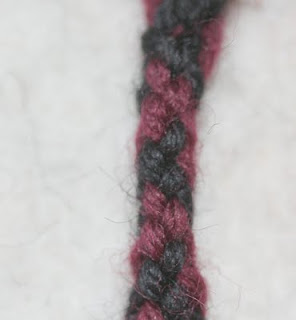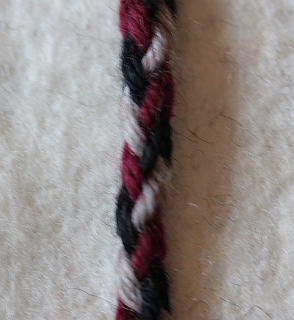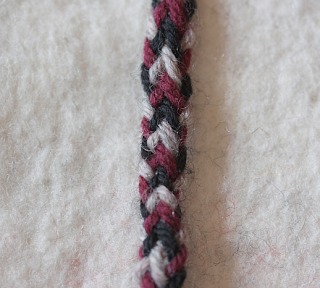I'm sorry this blog post comes so late, but I seem to have caught some kind of summer flu or similar illness. There will be no blog post tomorrow, but I hope to be fit and blogging again on Monday.
I have long been fascinated with fingerloop braiding (or loop manipulation braiding, if you prefer). It is an amazing technique with some disadvantages, but many advantages - the two most important, in my opinion, being ease of working and speed.
There has been a discussion recently in Cathy's costuming blog concerning the manufacture of a six-ended braid in red and yellow to go on a viking apron dress. And I'm afraid I haven't convinced the participants yet that fingerloop would be the thing to use...
What makes braiding difficult is the number of strands. Everybody who has done some single-end braiding knows this: While three ends are easy to handle, five ends demand considerably more attention and practice, and more ends even more so. For a braid with six ends, this means it will be quite time-consuming.
Here enters Fingerloop - to the rescue! With a loop-braiding pattern, it is possible to create almost any* traditional braiding pattern, with exactly half the amount of "ends" to handle. A six-end conventional braid becomes a very fast and easy three-loop-braid, resulting in the same braided pattern as the single-end version. For uneven numbers of ends, the solution is nearly as simple: for a five-end braid, just braid a normal five-loop pattern without turning any of the loops, and you'll end up with two five-end braids.
Because I find that the loops are much easier to handle than single ends, I personally do prefer the loop-braided version. The disadvantages are there - like a tendency to get a tighter braid towards the end, the stubbornness of mistakes (they are very hard to undo) and some technical difficulties for longer braids (though you can enlist somebody to carry the shed, or carry it with your toe, or even build a contraption for beating), but to me, they are far outweighed by the ease and speed of loop-braiding versus single-end braiding.
And to come back to Cathy's problem with the six-end braid, here are some possibilities for a three-loop braiding solution:
This is a simple three-loop braid, with loops consisting of one black and one red shank, both hands taking the loop turned (the lower shank becomes the upper shank on the other hand). It's quite firmly braided, bringing out a nice pattern of triangles in red and black.

This is the same setup, braided more loosely, with the loops turned 360° instead of 180° (so the same colour stays always on top).

This is a 3-loop braid made with 3 differently-coloured loops - one red, one black, one light gray, to show the structure better. Both hands taking their loop turned.

And this is the same setup, but only one hand taking the loop turned - resulting in a double-width band.

Such a double-width band with parted loops (half red half black) will result in a band that is black on the left and red on the right (or vice versa) if the loop taken turned is turned 360° and a kind of "checkered" band with black left and red right, then changing to red left and black right after a while and so on.
There are actually lots of variations using only two colours. And that's another thing I like with fingerloop - even if the colour scheme will not be intuitive, by changing the loop colours, making them from two differently coloured ends, or changing the turning sequence, many different variations can be produced.
*The exception to this is four-end whipcording. It's not possible to recreate this, but then, it's not necessary: whipcording is easily done with bobbins, and quite fast with two persons working.
I have long been fascinated with fingerloop braiding (or loop manipulation braiding, if you prefer). It is an amazing technique with some disadvantages, but many advantages - the two most important, in my opinion, being ease of working and speed.
There has been a discussion recently in Cathy's costuming blog concerning the manufacture of a six-ended braid in red and yellow to go on a viking apron dress. And I'm afraid I haven't convinced the participants yet that fingerloop would be the thing to use...
What makes braiding difficult is the number of strands. Everybody who has done some single-end braiding knows this: While three ends are easy to handle, five ends demand considerably more attention and practice, and more ends even more so. For a braid with six ends, this means it will be quite time-consuming.
Here enters Fingerloop - to the rescue! With a loop-braiding pattern, it is possible to create almost any* traditional braiding pattern, with exactly half the amount of "ends" to handle. A six-end conventional braid becomes a very fast and easy three-loop-braid, resulting in the same braided pattern as the single-end version. For uneven numbers of ends, the solution is nearly as simple: for a five-end braid, just braid a normal five-loop pattern without turning any of the loops, and you'll end up with two five-end braids.
Because I find that the loops are much easier to handle than single ends, I personally do prefer the loop-braided version. The disadvantages are there - like a tendency to get a tighter braid towards the end, the stubbornness of mistakes (they are very hard to undo) and some technical difficulties for longer braids (though you can enlist somebody to carry the shed, or carry it with your toe, or even build a contraption for beating), but to me, they are far outweighed by the ease and speed of loop-braiding versus single-end braiding.
And to come back to Cathy's problem with the six-end braid, here are some possibilities for a three-loop braiding solution:
This is a simple three-loop braid, with loops consisting of one black and one red shank, both hands taking the loop turned (the lower shank becomes the upper shank on the other hand). It's quite firmly braided, bringing out a nice pattern of triangles in red and black.

This is the same setup, braided more loosely, with the loops turned 360° instead of 180° (so the same colour stays always on top).

This is a 3-loop braid made with 3 differently-coloured loops - one red, one black, one light gray, to show the structure better. Both hands taking their loop turned.

And this is the same setup, but only one hand taking the loop turned - resulting in a double-width band.

Such a double-width band with parted loops (half red half black) will result in a band that is black on the left and red on the right (or vice versa) if the loop taken turned is turned 360° and a kind of "checkered" band with black left and red right, then changing to red left and black right after a while and so on.
There are actually lots of variations using only two colours. And that's another thing I like with fingerloop - even if the colour scheme will not be intuitive, by changing the loop colours, making them from two differently coloured ends, or changing the turning sequence, many different variations can be produced.
*The exception to this is four-end whipcording. It's not possible to recreate this, but then, it's not necessary: whipcording is easily done with bobbins, and quite fast with two persons working.



